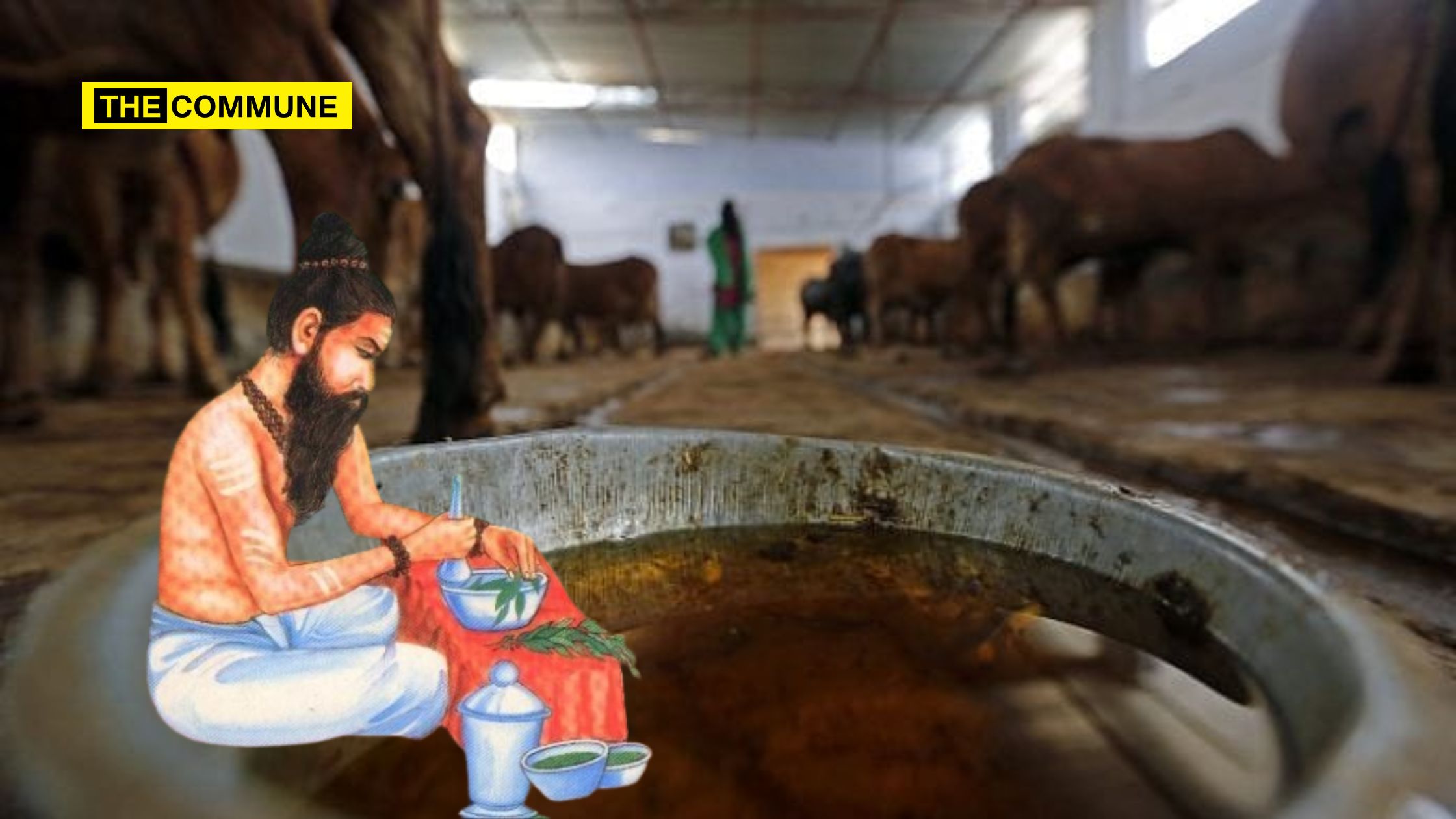
Ancient Siddha texts like Agasthiyar Gunapadam and Pathartha Guna Chintamani extensively document the medicinal properties of cow urine, citing its benefits for ailments such as inflammation, jaundice, and digestive disorders and emphasizing its role in traditional healing practices. Despite such historical validation, Dr. Kamakoti, IIT Madras director, faced controversy after his speech at a Mattu Pongal event where he highlighted cow protection and the importance of cow urine in sustainable agriculture. Dravidianist media focused on his reference to “gaumutra,” turning it into a flashpoint for political and ideological criticism, overshadowing his larger message on eco-friendly practices.
Dr. Kamakoti’s Speech
The director of IIT Madras, Dr Kamakoti, attended the Mattu Pongal celebrations at a cow shelter. During his visit, he delivered a 16-minute speech where he eloquently discussed various topics, including natural farming, using natural fertilizers, the importance of cow protection, and the significance of cows in sustainable agriculture. He shared his extensive experience and insights on these subjects without any hesitation, highlighting the wealth of knowledge he has accumulated about organic farming. He also spoke about the innovative water conservation methods he has implemented to support natural farming practices. His speech was a testament to his deep understanding and commitment to these traditional and eco-friendly agricultural practices.
He said, “Why do we earn? To fill this stomach. So we must eat good/healthy food. For that we need natural/organic farming and the foundation of organic farming is the cow. We can forget about organic farming if we do not have cowdung or cow urine. The cow must be a country cow/native. It is suited for our tropical climate. The dung that comes from a native cow has more power. So we must take more effort to protect these cows. The milk, dung and urine that they provide is very important for us.”
He further talked about the economic, nutritional, and environmental benefits. He also spoke about how Macaulay had stated that to destroy an economy, it was enough to destroy the native cow which was the foundation of organic farming. Continuing his speech, he said, “A great seer came and he was suffering from high fever. When asked if a doctor had to be called in, I forgot the seer’s name, he said, “Gomutram pinami“. He immediately brought in the cow urine and within 15 minutes of drinking, the fever subsided. So, it is antibacterial, antifungal, useful for digestive disorders and irritable bowel syndrome – it is a medicine, and we must take its medicinal value.”
Dr Kamakoti continued talking about the other benefits—biogas from cow dung—and encouraged people not to construct in fertile lands.
However, instead of focusing on the important points in his speech, Dravidianist media focused on the TRP-generating word – gaumutra/cow urine. For these Dravidianists and the Dravidian media, two factors came in very handy – one it was the IIT director who was involved, an institution with which they can attack the central government, and the other fact was he is a Brahmin, something that these Dravidianists relish.
Kerala’s CPIM government, is actively selling cow urine-based medicines through its state-owned ayurvedic company, Oushadhi. Oushadhi produces ‘Panchagavya Ghrutham,’ a five-ingredient medicine made from cow dung, cow urine, cow milk, ghee, and curd. The company claims that this formulation can cure mental diseases, jaundice, fever, epilepsy, and even improve memory and concentration. Notably, Oushadhi is one of the largest public-sector ayurveda companies in India, generating significant revenue for the Kerala government.
In 2021, the Kerala government even approached the Indian Council of Medical Research (ICMR) to explore the use of cow urine-based ayurvedic medicines for Covid-19 treatment. This move underscores the state’s endorsement of traditional remedies, including those derived from cow urine.
What Siddha Texts Say About Cow Urine/Gaumutra
Siddha is an ancient Indian traditional system of medicine that originated and flourished primarily in South India, particularly in Tamil Nadu. According to Siddha literature, this system of healing is believed to have divine origins, with Hindu God Shiva imparting its knowledge to his consort, Goddess Parvati. Parvati, in turn, passed this wisdom to Nandi, who then shared it with nine Devtas (divine beings).
The roots of Siddha medicine are considered divine and Tamil Hindu sage Agasthya Siddhar is revered as the founding father of this system. The tradition is further enriched by the contributions of 18 prominent Siddhars, who are regarded as the primary architects of Siddha medicine. The foundational texts and treatises of Siddha are written in the Tamil language.
In general, cow dung and urine is known for its antibacterial and antifungal properties. In villages, it is sprinkled across the house and in the frontyard to keep germs away. It is used on auspicious occassions too. Panchagavyam which constitues cow milk, ghee, curd, dung, and urine is also considered to have therapeutic properties and is also considered to be holy.
Let’s dig into this further.
The medicinal use of cow urine is not a recent development but is well-documented in several primary sources of Siddha medicine. These texts provide a detailed understanding of its properties, preparation methods, and applications.
1. Dhatu Seeva-Vaguppu
The book Dhatu Seeva-Vaguppu, authored by Dr. R. Thiagarajan, a Siddha practitioner and former professor, the publication rights for which belong to Tamil Nadu government was first published in 1958. This book, talks about formulation of medicine in Siddha – Gunapaadam.
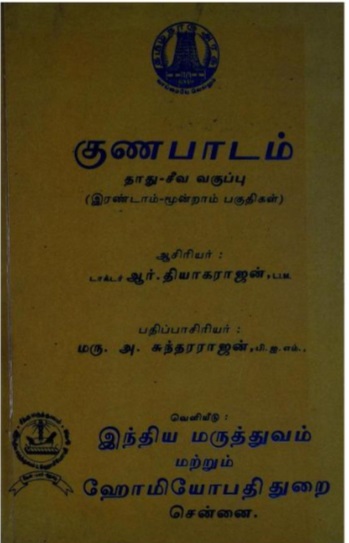
In this book, they talk about urine. The text says, “The urine of many animals belongs under medicine. Their properties are mentioned in the book titled “Pathartha Guna Cinthamani”.
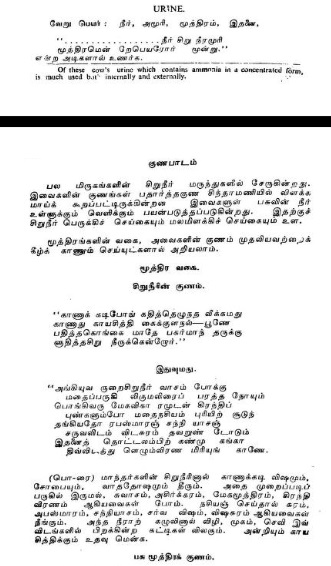
The book states, “The cow urine can be used for internal and external things. Cow urine is described as having diuretic (promotes urine production) and laxative (relieves constipation) properties.”
On the following page, the text discusses the medicinal benefits of human urine. It claims that, when consumed as prescribed, human urine can alleviate issues caused by vata dosha, cough, shortness of breath, and rheumatism. It also mentions that performing nasiyam (a specific procedure) with human urine can address conditions such as fever and poisoning. Additionally, washing with human urine is said to remove lumps or growths on the eyes, ears, and face.
The same book also highlights the properties of cow urine, noting its potential to cure various ailments, including jaundice, dental problems, inflammation, and more.
Then on page 654, it is written that dropsy (oedema), constipation, diarrhea, skin diseases, constipation can be cured by cow’s urine.
The book also talks about the properties of cow urine, buffalo urine, white goat urine, elephant urine, horse urine, as well as the properties of donkey urine.
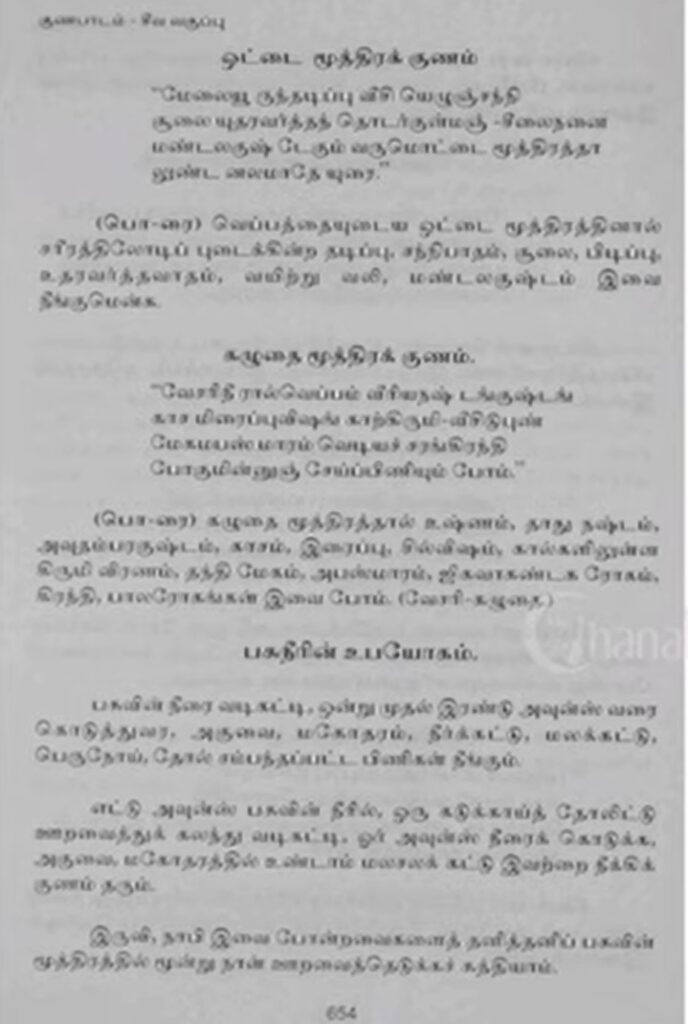
2. Pathartha Guna Chintamani
Thee book Pathartha Guna Chintamani also details on the medicinal properties of herbs.
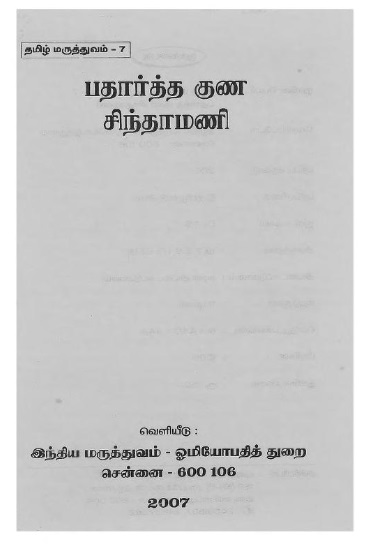
In the 173rd paragraph, it talks about cow urine. It talks of how it will heal inflammation and other diseases.
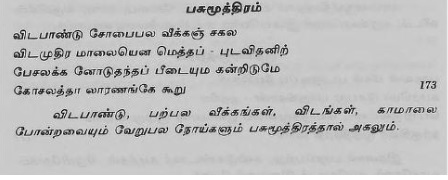
3. Agasthiyar Gunapadam
Compiled by the revered Siddhar Agasthiyar, this pharmacological text underscores the use of cow urine in treating liver diseases, digestive issues, and skin ailments. The text also discusses its antimicrobial properties and its use in cleansing the body of toxins.
4. Siddha Materia Medica (Gunapadam – Mooligai Vaguppu)
This modern compilation, authored by Dr. T. Thirunarayanan and others, builds upon the traditional Siddha pharmacological framework. Cow urine is described as a remedy for inflammatory conditions, jaundice, and respiratory ailments. The book also details preparation techniques to maximize its therapeutic efficacy.
5. Theraiyar Maha Karisal
This classical text highlights practical remedies, including cow urine, for addressing chronic conditions like joint pain and digestive issues. It emphasizes its role as a natural detoxifier and immune booster.
6. Bhogar 7000
Attributed to Siddhar Bhogar, this text mentions cow urine as part of several formulations used for treating skin diseases, respiratory problems, and other chronic conditions. Bhogar’s work reflects the Siddha philosophy of integrating natural substances for holistic healing.
7. Yugi Vaidhya Chinthamani
This seminal work by Siddhar Yugimuni discusses the diagnosis of diseases through naadi (pulse reading) and prescribes remedies such as cow urine for imbalances in the body’s humors.
8. Siddha Maruthuvanga Surukkam
This text provides a condensed overview of Siddha practices, detailing the use of cow urine in formulations for respiratory disorders, rheumatism, and skin conditions.
9. Siddha Pharmacopoeia of India (Volume I and II)
Published by the Ministry of AYUSH, this modern compendium validates traditional practices by detailing cow urine’s inclusion in official Siddha formulations. It highlights its significance in treating chronic ailments and promoting overall well-being.
From this, it is pretty clear that Tamil Siddha medicine considers cow urine as well as other animal urine and human urine to have medicinal properties.
Subscribe to our channels on Telegram, WhatsApp, and Instagram and get the best stories of the day delivered to you personally.




